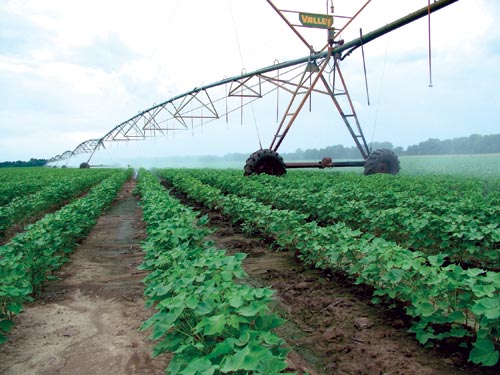
As seed treatments have improved, many cotton producers have already eliminated Temik in favor of seed treatment for early season thrips control.Temik still comes out on top versus seed treatments for control of secondary pests such as spider mites and aphids, according to Arkansas Extension entomologist Gus Lorenz.University of Arkansas Extension plant pathologist Scott Monfort says Temik’s biggest benefit for cotton producers has been control of nematodes in moderate to severe infestations.

This summer, Bayer CropScience and the Environmental Protection Agency entered into a voluntary agreement for Bayer to withdraw its registration and cease production of Temik (aldicarb). How will the loss of this chemical affect pest control in cotton?
Speaking at Cotton Incorporated’s Crop Management Seminar in Memphis, Arkansas Extension entomologist Gus Lorenz pointed out that many cotton producers have already eliminated Temik in favor of seed treatment for early season thrips control.
This is due primarily to the convenience of seed treatments versus Temik in-furrow, Lorenz noted. “There are no more stopped up tubes. No more forgetting to fill up the box.”
Lorenz says the transition from in-furrow treatments to seed treatments happened quickly. “In Arkansas, we went from being about 80 percent users of Temik in the 1990s, to less than 1 percent to 2 percent of our acreage being treated. How much the loss of Temik impacts us is questionable.”
According to Lorenz, studies indicated big differences between first generation seed treatment technology and Temik in terms of control of thrips.
“When the seed treatments first came out, we felt the Temik was still better for yield and profit,” Lorenz said. “But as they perfected the seed treatments, we began to see a change. We weren’t seeing the benefit from Temik. The seed treatments are doing just as well as the in-furrow.
“The obvious advantages to the seed treatments is the reduced toxicity and the application issues, which is why our growers made this transition to seed treatments,” Lorenz said.
Temik still comes out on top versus seed treatments for control of secondary pests such as spider mites and aphids, according to Lorenz.
Lorenz pointed to a survey of 150 Southeast cotton producers in 2004-05 which indicated that growers using Temik in-furrow had a 1 in 170 chance of having to treat for spider mites. For growers who relied on seed treatments alone, the odds of treatment went to a 1 in 17, almost a nine-fold difference.
Trials have shown that the use of Temik “did significantly decrease the spider mite population compared to seed treatments and foliar applications,” Lorenz said. “Visual inspection also indicated much less spider mite damage with Temik versus the seed treatments and the foliar applications.”
Aphids in cotton
Studies also show that Temik performs better than seed treatments for the suppression of aphids in cotton, according to Lorenz.
With the loss of Temik, “we just have to live with that situation and realize that these seed treatments are not going to help us out with these secondary pests.”
Lorenz says the loss of Temik not only deprives growers of a viable product, but it places more emphasis on the neonicotinoid class of chemistry used in many seed treatments. “There are not a lot of other products to depend on if we get into a serious situation. We’re depending on the industry to bring forward some new chemistry to help us out.”
University of Arkansas Extension plant pathologist Scott Monfort says Temik’s biggest benefit for cotton producers has been control of nematodes in moderate to severe infestations. “One reason Temik will be missed is because it has such a broad-spectrum. It’s helped us in a lot of different areas. It is the golden standard when we talk about nematode control.”
A study comparing seed treatments versus Temik in severely infested fields showed that Temik almost doubled yield versus an untreated check, while a seed treatment increased yield by almost 50 percent over the untreated. “In most moderate to severe situations, we’re going to have to combine some products. We can’t go at it with seed treatments alone. You’re not going to get the control you need.”
Producers can still use precision farming technology for site-specific applications of Telone for nematode control, according to Monfort. Studies have shown savings in Telone applications of 36 percent to 41 percent through site-specific techniques.
Monfort advises producers to not forget other problems in the field when implementing control measures for nematodes. “If you don’t correct your fertility or seedling disease problem, or if you don’t have a good idea of what nematodes will do behind corn or grain sorghum, or if you don’t fix your soil compaction problem, you can’t maximize the nematode control benefit. It all needs to come together as a system.”
For example, tests on the impact of tillage on nematodes showed yields of 750 pounds on untreated, un-ripped plots, 950 pounds with Telone, unripped plots, and 1,000 pounds with Telone, ripped plots. “If you don’t put out Telone and you still rip, it’s quite a bit better than un-ripped and untreated plots. Take care of all the problems,” Monfort said. “We don’t work in a vacuum.”
About the Author(s)
You May Also Like





